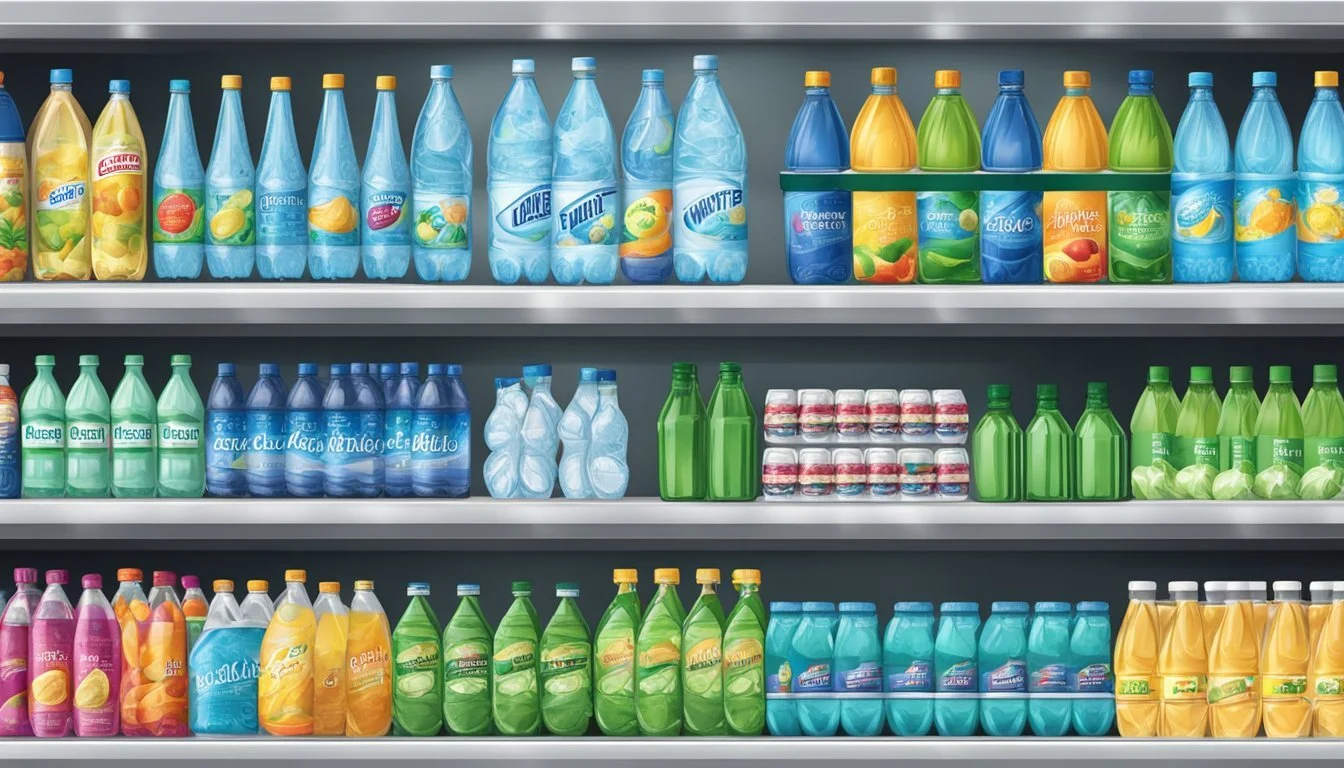Zenwtr vs. Big Win
Comparing the Best Bottled Waters
When it comes to choosing the best bottled water, consumers often find themselves deciding between well-known brands like ZenWTR and Big Win. ZenWTR, celebrated for its natural alkalinity with a pH of 9.5, offers a smoother taste and promises environmental benefits by reducing plastic pollution. On the other hand, Big Win provides an affordable and accessible option for a wide demographic.
For those seeking a premium alkaline water experience, ZenWTR stands out with its naturally balanced pH and high mineral content. Although more expensive, it caters to consumers who prioritize taste and environmental impact. Comparatively, Big Win's budget-friendly pricing and widespread availability make it a practical choice for everyday consumption.
With each brand presenting unique advantages, this head-to-head comparison aims to inform consumers about which bottled water best aligns with their preferences and values. Whether prioritizing sustainability and taste or affordability and convenience, this article will guide readers through an informed choice.
Overview of Bottled Water Industry
The bottled water industry is a large and dynamic market, with numerous players competing on price, quality, and environmental impact.
Market Leaders and Competitors
At the forefront of the industry, brands like Nestle Waters, Dasani, Aquafina, Fiji, and Evian dominate the market. These giants hold a significant share due to their extensive distribution networks and marketing efforts.
Essentia, Core, and Smartwater cater to the premium segment, emphasizing health benefits such as pH balance and mineral content.
Eco-conscious brands, including ZenWTR, are gaining traction. ZenWTR's use of 100% post-consumer recycled ocean-bound plastic sets it apart. Big Win, while not a leading brand, uses similar purification methods as Aquafina, targeting cost-conscious consumers.
Consumer Behavior and Trends
Consumer demand is driven by health, convenience, and environmental factors. Shoppers look for water that's not only pure but also packaged responsibly.
The rise of eco-conscious consumers has spurred brands like ZenWTR, highlighting sustainable practices. Health-conscious buyers often prefer brands with added benefits, such as Essentia's alkaline water.
Convenience continues to play a crucial role, with bottled water being a staple in grocery and convenience stores. Pricing remains a key factor, with consumers balancing between cost-saving options like Aquafina and premium brands like Fiji. The trend towards sustainability and health is reshaping the industry's landscape.
Unpacking Zenwtr and Big Win
Zenwtr and Big Win differ in terms of their brand origins, technological advancements, and market presence. These differences will shed light on their unique attributes and appeal to various consumer needs.
Company Profiles
Zenwtr was founded by Lance Collins, a veteran beverage entrepreneur dedicated to sustainable practices. The brand stands out for using 100% post-consumer recycled bottles fashioned out of ocean-bound plastic. This initiative is supported by endorsements from celebrities like Anne Hathaway.
Big Win, a brand under WALGREENS, aims to provide affordable bottled water. It lacks the high-profile backing and eco-friendly packaging focus that Zenwtr boasts.
Zenwtr targets premium customers with a high price point, while Big Win focuses on accessible pricing for everyday consumers.
Bottling Processes and Technologies
Zenwtr employs advanced filtration techniques with a specialized focus on alkalinity. It boasts a pH of 9.5, obtained through natural mineral content. The water undergoes purification processes including carbon filtration.
Big Win uses standard filtration and reverse osmosis techniques, similar to many mainstream bottled water brands. The focus is on efficient purification to offer clean and neutral-tasting water at a more affordable price.
The technological differences between the two brands influence both the taste and packaging, making each suitable for distinct target markets.
Health and Hydration
When comparing ZenWTR and Big Win bottled water, it's crucial to examine their health benefits, mainly focusing on hydration quality and nutritional content. Both brands approach hydration differently with variances in pH levels and the added value from electrolytes and minerals.
pH Level Comparisons
ZenWTR boasts a naturally balanced pH of 9.5, resulting in alkaline water. Alkaline water can help neutralize acidity in the body, potentially improving digestion and overall wellness. This natural alkalinity comes without artificial additives, being derived from its source.
Big Win, in contrast, typically offers purified water with a neutral pH close to 7. This is achieved through processes like reverse osmosis, which remove impurities but also strip the water of most minerals. While it provides clean hydration, it lacks the potential alkaline benefits that ZenWTR offers.
Added Value from Electrolytes and Minerals
ZenWTR includes essential minerals and electrolytes, enhancing its nutritional profile. Electrolytes like sodium, potassium, and magnesium are vital for maintaining hydration, regulating body temperature, and supporting physical performance. This mineral content also gives ZenWTR a smoother taste and can aid in quicker hydration and recovery after physical activities.
Big Win, focusing on purified water, generally does not add electrolytes or minerals. This makes it a straightforward hydration option, but it may not provide the same health benefits as ZenWTR. Athletes or those needing quick rehydration might find ZenWTR more beneficial due to its enhanced mineral content.
Environmental Impact and Sustainability
When comparing ZenWTR and Big Win bottled water brands, environmental impact becomes a crucial factor.
ZenWTR emphasizes the use of 100% recycled ocean-bound plastic in its bottles. This approach not only promotes recycling but also aids in ocean conservation by repurposing waste materials that would otherwise pollute coastal environments.
Big Win, on the other hand, focuses on using recyclable materials in its packaging. While it does not specifically use ocean-bound plastic, its packaging strategy still supports recycling efforts and aims to reduce plastic waste.
Energy consumption in the production process is another important consideration. ZenWTR aims to minimize its carbon footprint through various sustainable practices, contributing positively to the reduction of overall plastic pollution.
Pollution from plastic waste is a major environmental concern. ZenWTR's use of recycled materials helps alleviate this issue by turning potential waste into useful products. Big Win's recyclable packaging also helps mitigate plastic pollution, though to a different extent.
By choosing products with eco-friendly packaging, consumers can play a role in reducing the adverse environmental impact. Both ZenWTR and Big Win are taking steps toward sustainability and better practices for the planet.
Taste and Purity
When comparing the taste and purity of ZenWTR and Big Win bottled water brands, several factors such as flavor profiles, mineral content, and filtration processes come into play. Understanding these aspects can help consumers make informed choices based on their preferences.
Flavor Profiles and Preferences
ZenWTR is known for its naturally alkaline water, which can have a unique, smooth taste due to its mineral content. This type of water is often preferred by those seeking a subtle, refreshing flavor. Some users report that alkaline water can have a slightly sweet note, which may appeal to specific taste preferences.
Big Win, on the other hand, offers purified water that goes through reverse osmosis. This filtration process removes most impurities and minerals, resulting in a clean and neutral taste. While some may find this lack of mineral flavor appealing, others might consider it too bland compared to natural spring water options.
Taste tests often reveal that ZenWTR's flavor is well-received for its slight mineral essence, whereas Big Win's purified water is appreciated for its clarity and simplicity. Water sommeliers sometimes highlight the appealing taste of ZenWTR, attributing it to the natural spring source and minimal processing.
Purity and Contaminant Levels
ZenWTR prides itself on sourcing water from sustainable underground aquifers. This ensures a pristine water source that undergoes minimal filtration to preserve its natural integrity. Its filtration process is designed to maintain high purity without stripping away essential minerals.
Big Win, contrastingly, focuses on purified water through reverse osmosis, a method effective in removing contaminants. This results in water that meets stringent purity standards but lacks the natural mineral content found in spring water.
Both brands strive for high purity levels, but their approaches differ. ZenWTR emphasizes maintaining natural components, while Big Win ensures near-total removal of impurities.
Contaminant levels in both are minimal, aligning with safety standards. ZenWTR's naturally pure source and Big Win's thorough filtration offer consumers clean and safe hydration options.
Packaging and Accessibility
ZenWTR and Big Win take different approaches to packaging and accessibility, reflecting their brand values and target demographics.
Innovation in Recyclable Materials
ZenWTR leads with its commitment to sustainability, using 100% recycled ocean-bound plastic for its bottles. This eco-friendly approach resonates with environmentally conscious consumers. The company actively promotes its rPET (recycled PET) packaging, highlighting its significant reduction in plastic waste.
In comparison, Big Win employs traditional plastic water bottles, aiming for cost-effectiveness rather than innovation. While Big Win's standard packaging meets basic recycling standards, it lacks the novel eco-friendly appeal that ZenWTR champions.
Comparison of Pricing Strategies
ZenWTR positions itself in the premium market with prices ranging from $2 to $3 per bottle. This pricing underscores its use of high-quality materials and eco-friendly practices. Consumers pay a premium for the sustainability and alkaline water benefits offered by the brand.
Big Win, in contrast, is more budget-friendly, often pricing around $1 per bottle. This accessible pricing strategy makes it appealing to a broader demographic seeking affordability over premium features. Big Win's competitive pricing ensures it remains a staple choice among cost-conscious consumers.
Cultural and Celebrity Endorsements
ZenWTR leverages high-profile endorsements to enhance brand visibility. Notable figures like Lance Collins and Anne Hathaway serve as brand ambassadors, associating the brand with an eco-friendly and health-conscious image. These endorsements strengthen ZenWTR’s market position.
Big Win, however, does not rely heavily on celebrity endorsements. Instead, it benefits from commercial partnerships and widespread availability in retail chains, appealing to everyday consumers without the need for star power.
Alternative Products in the Market
The bottled water market offers numerous alternatives to ZenWTR and Big Win. Brands like Voss, LifeWtr, Acqua Panna, and Icelandic Glacial focus on premium and often eco-friendly packaging, similar to ZenWTR.
On the more budget-friendly end, brands such as Arrowhead, Deer Park, and Poland Spring compare to Big Win, offering accessible options without the higher price tag. Each brand brings different packaging innovations and accessibility strategies, catering to diverse consumer needs and preferences.
Consumer Accessibility and Distribution
ZenWTR is available in a variety of retail locations, including major grocery stores and convenience stores. Its distribution network expands across multiple regions, making it easy for consumers to find.
Big Win, similarly, is distributed in multiple channels. It is frequently found in grocery stores, offering a comparable level of accessibility.
Both brands have made efforts to ensure their products are easily accessible. ZenWTR’s focus on sustainability adds an extra layer of appeal for eco-conscious shoppers.
In terms of distribution reach, both brands are competitive. ZenWTR often highlights its environmental mission, which can differentiate it in a crowded market.
Comparing the two, they both offer strong retail presence and are easy to find for most consumers, whether they’re shopping at a grocery store or picking up a bottle at a convenience store.
More About Zenwtr
Mountain Valley Spring Water vs Zenwtr: Which Bottled Water is Better?
Richard's Rainwater vs Zenwtr: Which Bottled Water is Better?
Whole Foods Italian Still Mineral water vs Zenwtr: Which Bottled Water is Better?
Zenwtr vs Kirkland Signature: Which Bottled Water is Better?
More About Big Win
Big Win vs Kirkland Signature: Which Bottled Water is Better?
Icelandic Glacial vs Big Win: Which Bottled Water is Better?
Mountain Valley Spring Water vs Big Win: Which Bottled Water is Better?
Richard's Rainwater vs Big Win: Which Bottled Water is Better?
Whole Foods Italian Still Mineral water vs Big Win: Which Bottled Water is Better?






